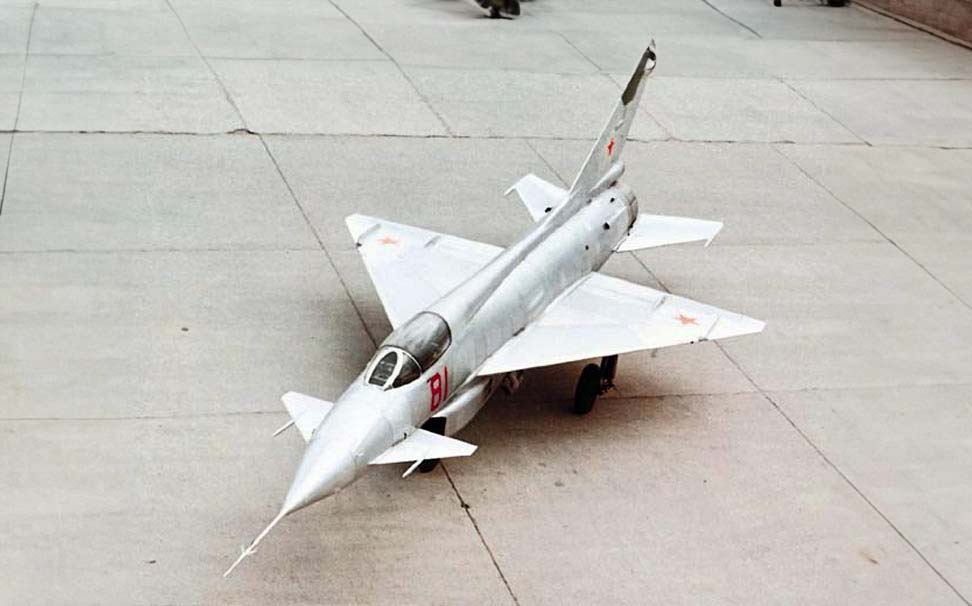Experimental Soviet interceptor, Ye-8/MiG-23 prototype, featuring a novel airframe and advanced avionics for its era.
In Brief
The Mikoyan-Gurevitch Ye-8, initially developed as an advanced prototype that laid the groundwork for the MiG-23 series, represented a significant leap in Soviet aviation technology. Designed in the early 1960s, it was aimed at surpassing the performance of contemporary Western fighters with its innovative features, including a variable-geometry wing, a powerful turbojet engine, and sophisticated radar and avionics systems. This aircraft was engineered for improved speed, agility, and combat effectiveness, incorporating a blend of aerodynamic refinements and technological advancements. It showcased the USSR’s capacity to innovate in the Cold War’s highly competitive military technology race.
History of the development
The Cold War era was a time of intense rivalry between the United States and the Soviet Union, both striving for supremacy in military technology. In this context, the Mikoyan-Gurevitch design bureau embarked on the development of the Ye-8, a project that aimed to challenge Western air superiority and meet the Soviet Air Force’s demand for a next-generation interceptor. Launched in the early 1960s by the Soviet Union, the Ye-8 project was a response to the evolving needs of aerial combat and the emergence of new Western aircraft that threatened to outclass existing Soviet fighters.
The Ye-8, which served as a prototype for the MiG-23, first took to the skies in 1962, marking a significant milestone in Soviet aviation. Although it did not enter mass production itself, the Ye-8’s innovations contributed to the development of the MiG-23, known by NATO as the “Flogger.” This nickname, like others assigned by NATO to Soviet aircraft, was part of a systematic approach to identify and classify potential threats. The MiG-23, which inherited the Ye-8’s technological advancements, became one of the most prolific jet fighters of the Cold War, serving in various roles from air superiority to ground attack.
Design of the Mikoyan-Gurevitch Ye-8 (Fishbed)
The Ye-8 was designed with several groundbreaking features that were revolutionary for its time. Its most notable innovation was the introduction of variable-geometry wings, allowing the aircraft to perform optimally across a wide range of speeds and altitudes. This adaptability enhanced its combat capabilities, providing a significant edge in dogfights and strike missions. The aircraft was powered by a single turbojet engine, capable of propelling it to speeds exceeding Mach 2. The integration of advanced radar and avionics systems further augmented its effectiveness in identifying and engaging targets.
The design of the Ye-8 also focused on improving maneuverability and reducing radar cross-section, which were critical in the high-stakes environment of aerial combat. The aircraft featured a streamlined airframe and was equipped with sophisticated weapons systems, including air-to-air missiles and a cannon for close engagement. These design choices reflected a balance between speed, agility, and firepower, making the Ye-8 a formidable contender against Western counterparts.

Performance of the Mikoyan-Gurevitch Ye-8 (Fishbed)
The performance of the Ye-8 was impressive by the standards of its time. Its engine provided a thrust-to-weight ratio that enabled high speed and rapid acceleration, crucial for intercept missions and evading enemy fire. The aircraft’s top speed approached Mach 2.2, and it could operate at altitudes exceeding 60,000 feet, giving it a significant operational ceiling advantage over many adversaries.
Comparatively, the Ye-8’s performance metrics were on par with or superior to many of its Western rivals, such as the F-4 Phantom II. Its variable-geometry wings allowed for excellent maneuverability at both high and low speeds, a feature that was relatively novel at the time. This adaptability made it a versatile and potent aircraft, capable of engaging a wide range of targets under various conditions.
Variants of the Mikoyan-Gurevitch Ye-8 (Fishbed)
The Ye-8 itself did not spawn multiple variants due to its prototype nature. However, its development directly influenced the design and specifications of the MiG-23 series. The MiG-23 came in several variants, each tailored to specific roles, including the MiG-23M (Flogger-B) as a frontline fighter, the MiG-23BN for ground attack, and the MiG-23MF, an export version with enhanced avionics. These variants showcased the flexibility of the original Ye-8 design, adapting to various combat roles and operational requirements.
Military Use and Combat of the Mikoyan-Gurevitch Ye-8 (Fishbed)
While the Ye-8 did not see combat itself, the MiG-23 series, its direct descendant, was extensively used in various conflicts. Equipped with air-to-air missiles, a cannon, and capable of carrying bombs and ground-attack missiles, the MiG-23 demonstrated versatility and effectiveness in combat. It saw action in the Middle East, participating in conflicts such as the Yom Kippur War, where it engaged Israeli aircraft, and in the Soviet-Afghan War, providing air support and engaging in air-to-air combat.
The MiG-23 was exported to numerous countries, further testament to its effectiveness and adaptability. It competed against a range of Western aircraft, including the F-4 Phantom II and the F-16 Fighting Falcon, in various theaters of operation. Although it was eventually phased out and replaced by more modern aircraft like the MiG-29 and Su-27, the legacy of the Ye-8’s innovations continued to influence Russian military aviation.
The Mikoyan-Gurevitch Ye-8 represented a pivotal step in Soviet aircraft design, introducing technologies that would shape the future of military aviation. Its legacy, carried forward by the MiG-23, underscores the importance of innovation and adaptability in the ever-evolving arena of aerial combat. The Ye-8’s contributions to the design and performance of Soviet fighters remain a significant chapter in the history of military aviation.
Back to the experimental aircraft section.